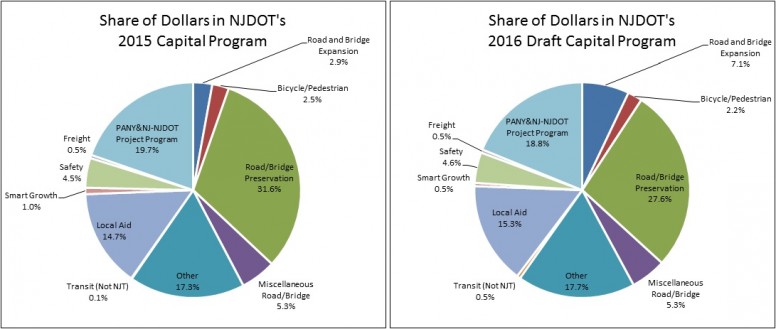After a tumultuous spring with no definitive solution to the Garden State’s transportation funding problems, the New Jersey Department of Transportation released a conservative Draft Transportation Capital Program that fails to take any bold action on the state’s infrastructure backlog, despite the fact that there are 621 deficient bridges, and more than a third of the state’s roads are in poor condition. The Capital Program is an annual project list of NJDOT’s planned road, bridge, and transit investments – a detailed tally of the state’s transportation priorities for the upcoming year.
This year’s priorities reflect a few key changes from 2015. Spending on road and bridge expansion increased from $54.4 million (2.9 percent) in 2015 to $132 million (7.1 percent) in 2016. This 243 percent increase in expansion projects would seem to signal a shift in priorities, but TSTC’s analysis* reveals the uptick in road and bridge expansion is due mainly to the inclusion of two major projects: the Route 72 Manahawkin Bay Bridge and the Route 295/42 Direct Connect project, which combine for $62.6 million in this year’s Capital Program. NJDOT pushed these two projects out of last year’s Capital Program because the state paid the construction contracts through until 2016. Together, these two projects represent a continuation of ongoing projects – not necessarily an increase in road expansion.

The real shortcoming in the 2016 Capital Program is a drop in funding for road and bridge preservation, which the state desperately needs to fix ailing pavement and crumbling bridges. NJDOT allotted $602.3 million to road and bridge preservation in the 2015 capital program, but has designated about $100 million less in this year’s capital plan, a 14.3 percent reduction. This cut represents an unfortunate step backwards after NJDOT increased its investment in systemwide preservation in last year’s Capital Program. Hopefully, a future fix to the Transportation Trust Fund will allow NJDOT to rightsize its funding priorities in the coming years.
Another unfortunate outcome of this Capital Program: a proposed reduction of bike and pedestrian project funding. Compared to last year’s $47.6 million investment, bike and pedestrian projects will receive nearly $7 million less, a decline of just over 14 percent. While this is a relatively small decline compared to the size of the overall Capital Program, bike and pedestrian projects tend to have an enormous return-on-investment, in spite of their relatively meager costs.
One bright spot in the Capital Program is the additional funding going to New Jersey Transit. Using an injection of federal funds, transit funding increased by 75 percent over last year’s levels to a total just over $2.1 billion. The lion’s share of this money (over $1.3 billion) will go to fund projects that improve resiliency, particularly stations and facilities damaged by Hurricane Sandy. A great deal of this resiliency money is funded by the Section 5324 program of MAP-21 which sets aside funds specifically for repairing infrastructure in the wake of natural disasters — which means this is only a one-shot funding mechanism that is not expected to be available in the long term.
Of course, this is only a draft Capital Program, which means investments are subject to change as NJDOT continues to tinker with it before a final document is released later this summer. And as one might predict, the debate over the future of the Transportation Trust Fund could force NJDOT to cancel a number of projects if additional funding isn’t secured – potentially rendering a great deal of the 2016 Capital Program dead on arrival.
*Starting in 2013, TSTC revised its analysis of the NJDOT Capital Programs in two significant ways. TSTC has gone through the DOT portion and classified each project in one of 12 categories: Road/Bridge Expansion; Bicycle/Pedestrian; Road/Bridge Preservation; Miscellaneous Road/Bridge; Transit (not NJT); Local Aid; Smart Growth; Safety; Freight; Non-DOT; PANYNJ Project Program; and Other. Non-DOT projects, not included in the analysis, total $355.8 million in the NJDOT portion of the 2016 proposed Transportation Capital Program and include the Port Authority’s Goethals Bridge replacement and the Bayonne Bridge Navigational Clearance Project. NJDOT describes these projects as “neither NJDOT nor NJTRANSIT–administered, but must be listed in the program because federal funds are attached to them.” By taking these projects out of the analysis, TSTC is able to convey a clearer picture of NJDOT’s planned spending.

[…] FY2016 program. This is a disappointing change, but as we noted in our discussion last summer on the draft capital program, the extra money for expansion is mostly explained by the inclusion of two major projects: […]